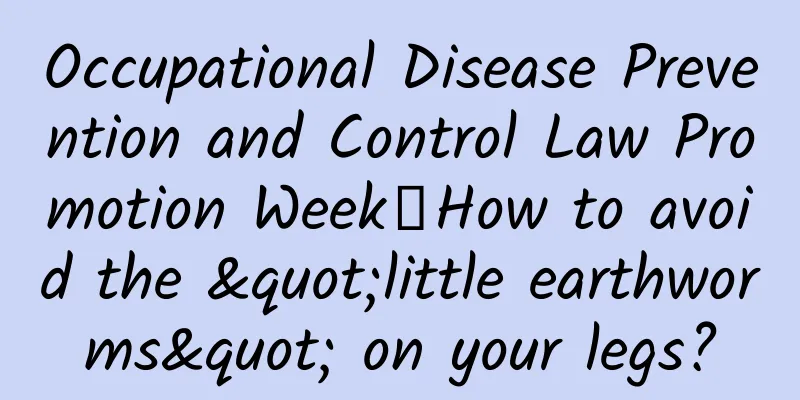Occupational Disease Prevention and Control Law Promotion Week丨How to avoid the "little earthworms" on your legs?

|
The Occupational Disease Prevention and Control Law Publicity Week is in full swing. I believe that everyone has a deeper understanding of statutory occupational diseases. But did you know that there is a large category of diseases that are related to work and are also seen in non-occupational populations, so not every case has an occupational history. When this type of disease occurs in occupational workers, due to exposure to occupational harmful factors, the original disease will be aggravated, accelerated or recurred. This type of disease is called work-related disease. Broadly speaking, occupational diseases also belong to work-related diseases. Common work-related illnesses, Including tension headaches caused by work stress, Peptic ulcer caused by high temperature work, Cervical spondylosis and mouse hand of "sedentary people", Teachers' pharyngitis and varicose veins in the lower limbs, etc. Today, I will introduce to you one of the work-related diseases that is easily overlooked: varicose veins of the lower limbs. Varicose veins of the lower limbs are common in teachers, surgeons, nurses, police officers and other occupations that require long periods of standing, or bank tellers, cashiers, office clerks and other people who sit for long periods of time. The main manifestations are dilation, elongation and tortuosity of the great saphenous veins of the lower limbs. It is a venous valvular disease that does not heal on its own and worsens year by year. There are no symptoms in the early stage. As the disease progresses, the affected limbs gradually become sore, weak, heavy, painful and itchy. In severe cases, complications such as leg ulcers or superficial phlebitis are often accompanied, and the skin becomes hard, ulcerated and blackened, forming "old rotten legs" and "ulcerative legs". The main causes of varicose veins: Weak vein walls, defective venous valves, and persistently elevated pressure in the superficial veins. When standing, the vertical gravity of the blood column increases the pressure on the lower limb veins. At the same time, the blood has to return to the heart from the farthest point, which can directly lead to damage of the great saphenous vein valve. Therefore, varicose veins of the great saphenous vein are more common in workers who stand for long periods of time. Depending on the severity of varicose veins, different treatment methods are chosen: 1. Patients with only small subcutaneous blood vessel dilation can be treated with elastic support (wearing elastic stockings or applying external pressure with elastic bandages) and drug treatment (intravenously active drugs such as flavonoids, saponins, etc.). 2. For patients with only vascular tortuosity, mild dilation, and no obvious discomfort, foam sclerosing agent injection can be used to close the dilated varicose veins. 3. For patients with moderate varicose veins, tortuous and protruding blood vessels in the lower limbs like earthworms, as well as lower limb soreness, swelling, and ulcer formation, minimally invasive treatment with radiofrequency ablation can be used. 4. For patients with severe varicose vein symptoms and obvious venous dilation, surgical treatments such as varicose vein stripping and high ligation of the great saphenous vein can be selected. Surgery is the only way to cure varicose veins of the lower limbs, but there is also the possibility of recurrence after surgery. Early detection and timely treatment, lifestyle changes and enhanced protection can effectively slow the progression of the disease. How to prevent: 01. Varicose veins have a genetic tendency, so you should prevent them early, exercise regularly, and strengthen your physical fitness. 02. Eat a balanced diet, prevent constipation, and avoid excessive obesity. 03. People who engage in standing work or heavy physical labor for a long time should wear medical elastic stockings to keep the superficial veins in a compressed state. 04. Pay attention to rest every day. Elevate your lower limbs when sleeping and massage moderately to promote blood circulation. 05. Avoid sitting for long periods of time and do moderate exercise (slow walking, cycling, etc.). Leg muscle contraction during activity can help venous blood return. Beware of varicose veins. Protect your legs. Take action! |
Recommend
2000 hcg in the morning urine the next day
Hcg is a very important female hormone in the fem...
What are the causes of irregular menstruation
Irregular menstruation is a manifestation of abno...
Symptoms of heart disease in women
Appearance is determined by the heart. The heart ...
What are the clinical manifestations of breast hyperplasia?
As a major reproductive organ of women, the breas...
Can I wear a garnet bracelet when I'm pregnant?
After a woman becomes pregnant, there are many th...
The ovarian artery arises from which artery
Everyone should know that the ovaries are importa...
What does fetal movement feel like at 19 weeks of pregnancy?
Nineteen weeks of pregnancy means about five mont...
National Science Popularization Day 2021 | Boost your confidence! More than 80% of lymphomas can be effectively controlled
September 15 World Lymphoma Awareness Day From CC...
What should I do if I bleed again half a month after abortion?
Recently, many couples have experienced unexpecte...
Pelvic inflammatory disease must wear a condom
Pelvic inflammatory disease is a common gynecolog...
Which universities in China offer psychology? How do you know if you are suitable for studying psychology?
Many young people like and are interested in psyc...
Female left lower abdominal pain
There are many reasons why women experience inter...
What should women do about menopausal syndrome?
In normal life, we often hear some middle-aged ma...
Gynecological medicine to remove odor
After entering spring, with the temperature risin...
Is it normal for vaginal discharge to be a little yellow?
Leucorrhea is a special fluid secreted by the fem...









